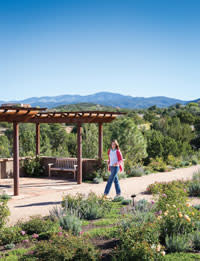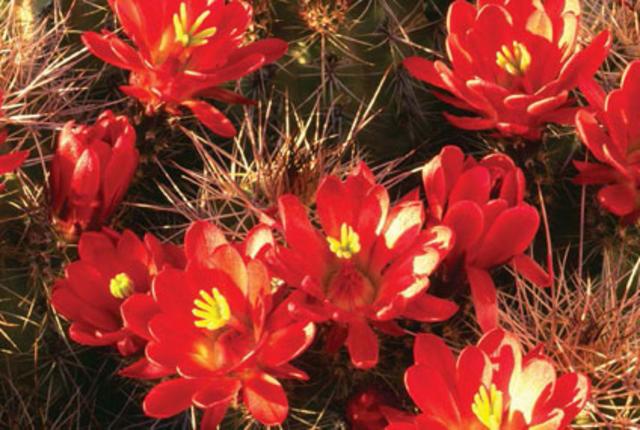
NEED TO KNOW
Santa Fe Botanical Garden
Where: 715 Camino Lejo, on Museum Hill Hours: Open daily, April–October, 9 a.m.–5 p.m. Guided tours at 10 a.m. and
2 p.m. Cost: $5; discounts for seniors, active military, and students. Children 12 and under free. Annual Membership: $35 for free admission to all three locations as well as free or reduced-cost admission to more than 300 botanic gardens nationwide. For more information on all of the Santa Fe Botanical Garden locations: (505) 471-9103; santafebotanicalgarden.org
Blooming New Mexico
Where can you see the desert turn green—and pink, red, white, and yellow? Here are a few options.
The Rio Grande Botanic Garden Part of the Albuquerque Biological Park, which includes a don’t-miss zoo and aquarium, this big daddy of New Mexico gardens includes 52 acres of xeriscapes, a Japanese garden, butterfly pavilion, heritage farm, and more. 2601 Central Ave. NW; (505) 768- 2000; bioparksociety.org/botanicgarden
The Albuquerque Rose Garden More than 1,200 bushes of hybrids, floribundas, rugosas, miniatures, climbers, and more welcome visitors to the Tony Hillerman Library. Members of the Albuquerque Rose Society offer regular sessions on pruning and growing your own. 8205 Apache Ave. NE; albuquerquerose.com/garden
The University of New Mexico Campus Arboretum Learning continues outside the classroom with UNM’s impressive landscape of trees, bushes, grasses, and flowers. Drop into the Welcome Center in the Cornell Parking Structure for info on self-guided tours. Welcome Center parking: 2401 Redondo Dr. NE; (505) 277-1938; pats.unm.edu
Living Desert Zoo & Gardens State Park Animals and plants native to the Chihuahuan Desert enrich a visit to nearby Carlsbad Caverns. 1504 Miehls Dr., Carlsbad; (575) 887-5516; emnrd.state.nm.us/SPD/livingdes ertstatepark
City of Rocks State Park Located between Silver City and Deming, the park’s botanical garden shows off cacti, ocotillo, agave, desert bird of paradise, and even oak shrubs. Keep an eye out for desert tortoises, too. 327 Highway 61, Faywood; (575) 536-2800; gilawilderness.com/travel/cityofrocks.htm
Chile Pepper Institute Teaching Garden New Mexico State University scientists know more about New Mexico’s favorite food than almost anyone on earth. Tours, both self-guided and guided, June–Oct.; 113 W. University Ave., Las Cruces; (575) 646-3661; chilepepperinstitute.org
Farmington Demonstration Garden Master Gardeners and NMSU’s Agricultural Sciences Center oversee this xeriscape with selfguided walking tours and an annual Mother’s Day event. 300 Road 4063, Farmington. (505) 960-7757; farmingtonsc.nmsu.edu/xeriscape
Rio Rancho WaterWise Garden Another mash-up of Master Gardeners and NMSU, demonstrating xeriscape principles. 950 Pine Tree Rd., Rio Rancho; (505) 867-2582; rioranchowaterwisegarden.wordpress.com
Winter chose to tarry the day I met Clayton Bass at the Santa Fe Botanical Garden. Swathed in sweaters, we wandered a meandering path flanked by gloriously stacked rocks, with not a single flower
in sight.
No matter. We gardeners possess imaginations best described as—ahem— florid. Even when the sky whispers “snow,” we dream of spring.
“You’re seeing things begin to bloom in April,” said Bass, the organization’s chief executive officer, sweeping his arm past furry blankets of yellowed grasses. Together, our minds beheld the branches of fruit trees sprinkled with blossoms. Around their roots, a circular field of flowering bulbs enacted a horticultural rhapsody in blue. Butterflies and hummingbirds appeared.
We moved to the heart of the garden, a 14-acre dream that’s taking root atop Museum Hill just across Camino Lejo from the Wheelwright Museum, Museum of International Folk Art, Museum of Indian Arts and Culture, and Museum of Spanish Colonial Art. The two acres of phase one opened last July, making this the garden’s first “real” spring.
“We should have a pretty spectacular bloom,” Bass said.
To create this oasis, the garden hired internationally renowned landscaper W. Gary Smith, whose work includes the Children’s Garden at the Lady Bird Johnson Wildflower Center, in Austin, and restoration of the 60-acre garden at Henry Francis du Pont’s historic Winterthur estate, in Delaware. Along with professional crews and an army of volunteers, he combined the realities of desert life with the rose-garden fantasies of longtime supporters. Concerns over water conservation guided them, including the creation of La Rambla, a twisting creek bed that encourages each drop of rain to slow down and seep in.
The flora ranges from agaves, chollas, and yuccas to poppies, herbs, evergreens, oaks, and more. Most are indigenous, though some hail from parallel climate zones around the globe. For someone who’s lost her share of gardening struggles, the bounty put me into something akin to a sugar stupor. Bass assured me that was part of the plan.
“We bring together in a concentrated place a way to view the variety of plants you might see across New Mexico that are hard to grow so closely together,” he said. “And it’s all in this extraordinary location with a beautiful view of the mountains and access to four world-class museums. “You could park once and spend the day. That’s pretty fantastic.”
Botanic gardens, by definition, are places of learning. Once the province of scientists studying the medicinal benefits of plants, they evolved into public emporiums that invite agronomists and amateurs alike. To serve its educational purpose, the Santa Fe Botanical Garden built in stopping points under soon-to-be vine-covered ramadas to shelter classes and tour groups. And it went one step further by incorporating the City Different’s artistic sensibilities.
Bass and I marveled at clay sculptor Christy Hengst’s whimsical birds, screen-printed with texts and images in mimeograph blue (on exhibit through May 31). On April 26, the garden will open a temporary show of Kevin Box’s origami-like metal sculptures.
Candyce Garrett’s three-piece granite Emergence, commands phase one’s permanent installation space. In coming years, phases two and three will feature sculptures by Tom Joyce and Ramón José López.
Other highlights include the restoration of a WPA-era gabion, a rock structure that supports the property’s arroyo, and a flaming-red bridge that once served road duty near Las Vegas, New Mexico.
“We packed a lot into two acres,” Bass said. “We sought to create a soothing public space. You see people hanging out on the benches reading or having a conversation. We want people to connect with nature, and we feel this is a good place to do it.”
It’s about time. The SFBG organization has gone 26 years without a botanic garden of its own, although it has long claimed two spectacular natural habitats. The Lenora Curtin Wetland Preserve, in La Cienega, demonstrates what happens “when you add water to the desert,” Bass said. The Ortiz Mountains Educational Preserve shows off a high-altitude environment near Cerrillos.
Obtaining a garden, though, took years of hunting for a location and refining many gardeners’ competing visions into a plan certain to attract as many visitors as butterflies. Well before its first birthday and just a third of its eventual size, it’s hitting the mark.
As Bass and I chatted, a young couple strolled past. Something in the way they moved tipped me off. “I think they’re sizing this up for a wedding,” I murmured.
“Oh, absolutely,” Bass whispered back. “I figured them for that immediately. We’ve already had two weddings. I’d like to see musical performances, Shakespeare in the garden—the possibilities are limitless.”
We were at the exit gate, but I didn’t want to leave. I wanted to keep wandering until the green tips of grape hyacinth poked through the cold soil. I wanted to see the peach trees bathed in blooms. I wanted to hear the buzz of bees. Apparently, I’m not alone.
“In one year, we’ve gone from 600 members to 1,500,” Bass said.
His count was shy by one. On the way out, I picked up a membership form, determined to make this the new garden of my dreams. ✜
Kate Nelson, an award-winning journalist and author of the biography Helen Hardin: A Straight Line Curved, lends volunteer labor to the native-plants garden and labyrinth at the Placitas Community Library.


